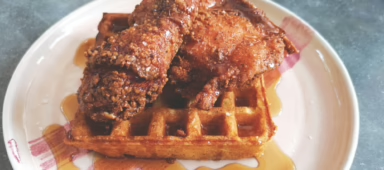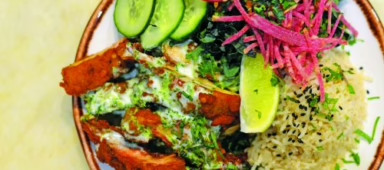In an ever-changing world, Tokyo sushi remains a cut above

Like silver torpedoes, a succession of shiny yellowfin tuna slide down a plastic ramp onto the wet concrete floor. Overalls slick with blood and water, the fishermen of the battered trawler Shinsei Maru eye each fish with tired satisfaction. Here in Kii-Katsuura, a bustling fishing town on the southeast coast of Japan, a big tuna catch means a big pay day.
_386_257.jpg)
Encased in ice, most of the Shinsei Maru's tuna is rushed straight to Tokyo, 500 kilometres northeast as the crow flies. The average Japanese eats almost 70 kilogrammes of fish every year – most of this comes in the form of sushi and sashimi. Every day, the Japanese capital's insatiable appetite for seafood is fed by an incessant flow of tuna and other marine species, harvested from across the world's oceans.
Tokyo is intimately connected with the evolution of sushi. It was here, when the city was known as Edo, that sushi was conceived in the mid-19th century, born out of a wide range of ‘sushi foods’ which describe any that incorporate vinegared rice.
_386_528.jpg)
“The very word sushi, in fact, means 'pickled rice' in Japanese, and doesn't refer to seafood at all,” explains Steve Parker, a long-term Tokyo expat and self-confessed raw fish addict. “It's just one of the many misconceptions that abound when it comes to sushi.”
Within today's sushi system, tuna is the trophy fish – the species demanded above all others by the gourmand. It is the litmus test of any sushi restaurant’s culinary pre-eminence.
_386_257.jpg)
“In Tokyo, if you offer your clientele good tuna, you have the reputation of being a proper restaurant,” says Parker. “Tuna is the Beluga caviar, the white truffle of sushi.”
When a chef creates nigiri (hand-formed) sushi, the rice is moulded by hand into a small clump, and a fine slice of fish, tuna or otherwise, is pressed on top. In some cases a paper-thin ring of nori (toasted seaweed) is used to bind the layers together. To the uninitiated, the process seems simple. But in Tokyo, it takes years to master.
_386_603.jpg)
“Most non-Japanese people don't really appreciate how tough it is to become a true sushi artist,” says Australian chef David Carter, a recent graduate of the Tokyo Sushi Academy (sushischool.jp). “It is incredibly tough to make it to the top as a Tokyo sushi chef.”
Established in 2002 in the heart of the capital's Shinjuku District, the academy is the only sushi chef training school in the country that enrols both Japanese and non-Japanese. But the academy is changing the playing field in other ways. It also admits women and slashes years off the standard sushi apprenticeship.
In Japan, a sushi chef, or itamae-san (“he who is in front of the board”), traditionally goes through at least seven years of training before he (or she) is licensed to cut fish in front of customers. The first couple of years are typically spent washing dishes and performing other, less desirable chores.
“Sushi chefs work their way up very slowly, from the very bottom,” says Tokyo-based food guide Keiko Nagamatsu. “Understandably this puts a lot of people off. The Tokyo Sushi Academy, however, lets novices fast-track the process. It's not cheap, but it does mean cleaning fewer floors and toilets.” An eight-week diploma course will set one back around USD8,400.
_386_579.jpg)
Visit any Tokyo sushi restaurant and the chances of seeing a woman behind the counter are slim to non-existent. Today, the world of sushi remains a largely male preserve.
“The reasons for this are as deep-rooted as they are spurious,” says Nagamatsu bluntly. “Make-up, body lotion and perfume will contaminate the sushi. The woman's hands are too warm. Women can't hold the knife properly. I mean if the gender barrier wasn't so real, it would be pretty laughable.”
_386_579.jpg)
The barrier was breached, ever so slightly, when Tokyo’s first sushi eatery featuring female-only chefs opened for business in late 2010. Every day at Nadeshico Sushi, an array of young women line up behind the sushi bar, carefully creating nigiri while they chat with the (predominantly male) clientele. The sushi might not win any prizes, but is slowly changing the perception that women and sushi should never mix.
There is one place in Tokyo where tons of tuna are regularly touched by both men and women. At Tsukiji Market, the Japanese capital's fascinating and pre-eminent seafood bazaar, raw fish worth over USD15 million is sold at auction every day. This year's most expensive tuna sold at Tsukiji for more than USD70,000, or around USD300 per kilo.
_386_257.jpg)
Sprawling over 20 hectares, Tsukiji is nevertheless cramped and congested. Plans are now afoot to relocate the market to a new site in Tokyo Bay before the Japanese capital hosts the 2020 Summer Olympics. Resistance from some has been fierce, but as Tokyo’s sushi traditionalists are now finding out, nothing stays the same forever.
Malaysia Airlines flies direct from Kuala Lumpur to Tokyo. For more information visit www.malaysiaairlines.com for more information.





